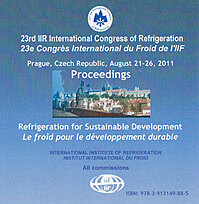
IIR document
A simple method for calculating the maximun heat transfer rate of a counterflow heat exchanger.
Number: pap. ID: 345
Author(s) : SIERES J., MARTíNEZ-SUÁREZ J. A., VARAS F., et al.
Summary
The heat transfer effectiveness is one of the basic design methods used in heat exchanger analysis. It can be used to determine the total heat transfer rate between the hot and cold fluids of a heat exchanger, when the maximum or ideal heat transfer rate is known. This paper presents a method to evaluate the maximum heat transfer rate that can occur in a counter-current heat exchanger. It considers the possibility that one or both fluids may undergo a phase change and also that either fluid may behave as a pure fluid or a zeotropic mixture. Depending on the inlet conditions of the hot and cold fluids, the maximum possible heat transfer rate may be obtained when the outlet temperature of one fluid equals the inlet temperature of the other or when an internal temperature pinch occurs. Expressions to determine the maximum heat transfer rate for each situation are presented.
Available documents
Format PDF
Pages: 8 p.
Available
Public price
20 €
Member price*
Free
* Best rate depending on membership category (see the detailed benefits of individual and corporate memberships).
Details
- Original title: A simple method for calculating the maximun heat transfer rate of a counterflow heat exchanger.
- Record ID : 30002547
- Languages: English
- Source: Proceedings of the 23rd IIR International Congress of Refrigeration: Prague, Czech Republic, August 21-26, 2011. Overarching theme: Refrigeration for Sustainable Development.
- Publication date: 2011/08/21
Links
See other articles from the proceedings (569)
See the conference proceedings
Indexing
-
Coil side heat transfer characteristics study f...
- Author(s) : LIN J. Y., LIN J. W., SHIH Y. C.
- Date : 2015/08/16
- Languages : English
- Source: Proceedings of the 24th IIR International Congress of Refrigeration: Yokohama, Japan, August 16-22, 2015.
- Formats : PDF
View record
-
Airside performance correlations and optimal ai...
- Author(s) : BACELLAR D., AUTE V., RADERMACHER R.
- Date : 2016/07/11
- Languages : English
- Source: 2016 Purdue Conferences. 16th International Refrigeration and Air-Conditioning Conference at Purdue.
- Formats : PDF
View record
-
Wavy fin profile optimization using NURBS for a...
- Author(s) : BACELLAR D., AUTE V., RADERMACHER R.
- Date : 2016/07/11
- Languages : English
- Source: 2016 Purdue Conferences. 16th International Refrigeration and Air-Conditioning Conference at Purdue.
- Formats : PDF
View record
-
CFD based comparison of slit fin and louver fin...
- Author(s) : SARPOTDAR S., NASUTA D., AUTE V.
- Date : 2016/07/11
- Languages : English
- Source: 2016 Purdue Conferences. 16th International Refrigeration and Air-Conditioning Conference at Purdue.
- Formats : PDF
View record
-
Multivariate optimization of a heat exchanger w...
- Author(s) : GLAZAR V., TRP A., LENIC K., et al.
- Date : 2015/08/16
- Languages : English
- Source: Proceedings of the 24th IIR International Congress of Refrigeration: Yokohama, Japan, August 16-22, 2015.
- Formats : PDF
View record
